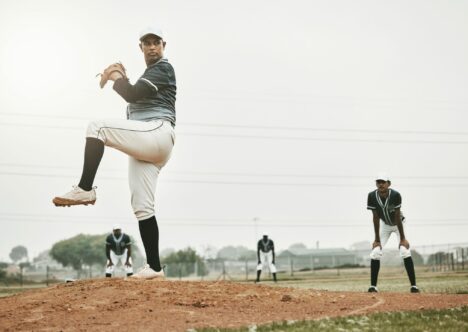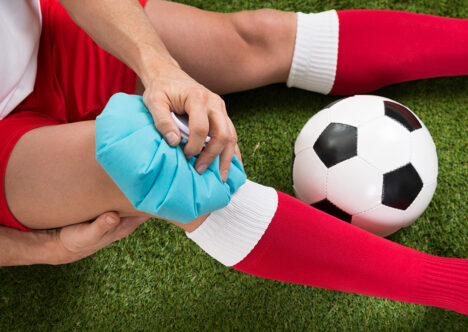Use our convenient online scheduler to book an appointment now.

Did you know that children and teens experience more than 3.5 million sports-related injuries each year?
Participating in sports is a valuable way for kids to stay active, make friends, and learn about teamwork and responsibility. But like any physical activity, playing sports can lead to injuries. Some sports tend to cause more injuries than others, and cautious parents might question whether or not to expose their children to high-risk activities.
Our orthopedic experts have put together this helpful guide to the top five most dangerous sports for youth. We hope this guide will help parents make informed decisions when it comes to the sports their children play. We’ve also included some prevention strategies that should be helpful for anyone involved in youth sports — coaches, parents, or players.
The Top 5 Most Dangerous Youth Sports
It’s difficult to establish a definitive list of which sports are most dangerous for children. There are some sports, like football, which are played by millions of children and which cause a large number of often minor injuries, while at the same time there are outliers like gymnastics and cheerleading, which, given the smaller number of participants, cause fewer overall injuries per year. However, those injuries are often catastrophic.

Our list looks at the sports which are most commonly played by young people, often in a school setting, and which cause a large number of injuries each year. Participation in any of these sports can be hugely beneficial for children, but can often lead to injury if proper care isn’t taken.
Football
Any contact sport is going to be risky for young players, and football tops the list when it comes to injuries. Nearly 400,000 football players between the ages of five and 14 are treated for musculoskeletal injuries each year.
More worryingly, concussion affects 1 in 10 youth athletes every year. Repeated blows to the head can lead to chronic traumatic encephalopathy—more commonly known as CTE. CTE can result in problems such as confusion, impaired judgment, memory loss, and impulsive behavior.
Common Injuries
- ACL tears and MCL sprains
- Meniscus tears
- Concussions
- Fractures of the finger, ankle, and wrist
- Muscle strains
Basketball
Despite basketball not being known as a contact sport, there are still over 170,000 basketball-related injuries in kids under 15 each year that require treatment in a hospital setting. Sudden movements, pivoting, and driving to the net can all lead to serious injury.
Common Injuries
- Ankle sprains, strains, and fractures
- ACL tears
- Torn ligaments
- Jammed fingers
- Knee injuries
Soccer
Soccer’s global popularity has spread to the United States, and an increasing number of parents sign their kids up for youth soccer leagues and school teams every year. Soccer helps players develop coordination, endurance, and teamwork skills, but it can also be risky. Between 1990 and 2014, nearly three million young soccer players ended up in the ER with various injuries.
Common Injuries
- Strains and sprains
- Fractures
- Soft tissue injuries
- Scrapes and cuts
- Concussions
Hockey
The greatest game on ice, hockey has a long history of popularity in Canada and the United States. Unfortunately, it’s a rough sport, with youth players as young as 12 permitted to check their opponents with a defensive slam against the boards. Just like in professional hockey, youth hockey players sustain most of their injuries due to hard checking.
Common Injuries
- Dislocated shoulders
- MCL tears
- Fractured collarbones
- Concussions
- Ankle sprains
Baseball
Rounding out the list of the top five most dangerous youth sports is baseball. Nearly 110,000 children ages 5 to 14 were treated in emergency rooms for baseball-related injuries each year. While baseball is relatively safe, sometimes rare and fatal incidents do occur. Pitchers are particularly susceptible to overuse injuries from repetitive throwing motions.
Common Injuries
- Rotator cuff tears
- Knee strains
- Neck and back issues
- Ankle sprains and fractures
- Pulled hamstrings or quads
Learn How to Prevent Overuse Injuries in Athletes
Treatments & Prevention Strategies
While it’s hard to eliminate the risk of sports injuries sustained by youth players, there are ways to reduce those risks.
- Use proper stretching techniques
- Encourage relevant strength training
- Ensure your child has well-fitting gear, especially a properly sized helmet
- Make sure your child stays hydrated and maintains proper nutrition
- Learn how to identify concussion signs and symptoms
Depending on the type of injury, treatments may include conservative strategies like immobilization of the affected area, R.I.C.E. (rest, ice, compression, and elevation), and anti-inflammatories, or more aggressive techniques such as arthroscopic procedures for ACL or meniscal tears.
Of course, good nutrition, hydration, sleep, stretching, strength training, and proper equipment all play a role in keeping athletes safe and injury-free.
Your Youth Athlete Deserves Expert Care
If your young athlete plays any of these top five most dangerous sports for youth, it’s important that more serious conditions are addressed by board-certified and fellowship-trained physicians specializing in sports medicine. As a leading provider of high-quality, state-of-the-art care for patients throughout the Commonwealth of Virginia, the orthopedic experts at Town Center Orthopaedics evaluate each unique case with the duty, care, and attention it deserves.
Our patient-centered approach means that you will be involved in every step of the process to ultimately achieve the best outcome for your child.
To speak with a specialist or to schedule your appointment, call Town Center Orthopaedics any time at (571) 250-5660, or request an appointment today.
Join our Mailing List
TCO provides patients with orthopedic problems the trusted resources and patient-centered advice they need to “Feel Better. Move Better. Be Better.”
© 2024 Town Center Orthopaedics | All Rights Reserved


